The Implementation of NHT and GQGA Learning Model to Enhance Student’s Liveliness and Cognitive Learning Outcomes.
Abstract
The objectives of the research are: (1) to identify whether the use of Numbered Heads Together (NHT) and Giving Question Getting Answer (GQGA) can improve the students’ activeness in peripheral reparation at X TKJ SMK Muhammadiyah 2 Ngawi in the school year of 2015/2016; (2) to identify whether the use of Numbered Heads Together (NHT) and Giving Question Getting Answer (GQGA) can improve the students’ cognitive learning outcomes at X TKJ SMK Muhammadiyah 2 Ngawi in the school year of 2015/2016. This research was classroom action research which conducted in two cycles. Each cycle consisted of planning, action, observation, and reflection from March until April 2016. The subject of research was the X TKJ grade of SMK Muhammadiyah 2 Ngawi in the school year of 2015/2016. The research data were collected by using techniques of interview, observation, tests (pre-test and post-test), documentation. The qualitative data were validated by using triangulations, and then the quantitative data were validated by using content validity. The qualitative data were analysed by using reduction, presentation, verification, conclusion, and then the quantitative data were analysed by using descriptive statistics. The results showed that the implementation of collaboration NHT and GQGA improved the activeness and cognitive learning outcomes. The percentage of activeness before the implementation of collaboration NHT and GQGA was 19,44%, after that 61,54% in cycle I, and 69,23% in cycle II. The cognitive learning outcomes also increased. The percentage of the qualified students was 38,46%, after that 51,28% in cycle I, and 71,79% in cycle II. From the results above, it can be concluded that the implementation of collaboration NHT and GQGA can improve the activeness and learning outcomes in peripheral reparation at X TKJ students of SMK Muhammadiyah 2 Ngawi in the school year of 2015/2016.

This work is licensed under a Creative Commons Attribution-ShareAlike 4.0 International License.
Keywords
Full Text:
PDFReferences
Ahmadi, I.K., Amri, & Elisah (2011). Strategi Pembelajaran Sekolah terpadu. Jakarta: Prestasi Pustaka.
Annurahman. (2014). Belajar dan Pembelajaran. Bandung: Alfabeta.
Astri, K. (2012). Peningkatan Keaktifan dan Prestasi Belajar Siswa pada Pembelajaran Kewirausahaan dengan Model Pembelajaran Kooperatif Tipe NHT (Numbered Heads Together) di SMK Negeri 8 Purworejo, Hlm 12-46. LPPM Universitas Negeri Yogyakarta.
Daryanto. (2009). Panduan Proses Pembelajaran Kreatif &Inovatif. Jakarta: AV Publisher.
Daryanto dan Muljo Rahardjo (2012). Model Pembelajaran Inovatif. Yogyakarta: Gava Media.
Dimyati & Mudjiono. (2013). Belajar &Pembelajaran. Jakarta: Rineka Cipta.
Misu, L. (2014). Mathematical Problem Solving of Student by Approach Behavior Learning Theory. International Journal of Education and Research, 2 (10, 181). Diperoleh pada 11 Juni 2016, dari http://eprints.uny.ac.id/24329/
Purwanto. (2014). Evaluasi Hasil Belajar. Yogyakarta: Pustaka Pelajar.
Santoso, T.N.B. (2015). Penerapan Kolaborasi Model Pembelajaran Kooperatif Tipe Think Pair Share (TPS) dengan Talking Stick untuk Meningkatkan Keaktifan dan Hasil Belajar Siswa dalam Mata Pelajaran Administrasi Kepegawaian, Hlm 25-28 . LPPM Universitas Sebelas Maret.
Sarutobi, A. (2010). Pentingnya Keaktifan Siswa dalam Pembelajaran. Diperoleh 7 Juni 2016, dari http://ardiyansarutobi.blogspot.co.id/2010/11/pentingnya-keaktifan-siswa-dalam.html.
Syah, M. (2003). Psikologi Belajar Catatan II. Jakarta: PT Raja Grafindo Persada
Thobroni, M. (2015). Belajar dan Pembelajaran: Teori dan Praktik. Yogyakarta: Ar-Ruzz Media.
Widoyoko, E.P. (2016). Teknik Penyusunan Instrumen Penelitian. Yogyakarta: Pustaka Pelajar.
Wijayanti, S. (2014). Penerapan Model Pembelajaran Giving Question and Getting Answer (GQGA) untuk Meningkatkan Keaktifan Belajar Siswa. Kumpulan Abstrak Hasil Penelitian Universitas Muhammadiyah Purworejo Tahun 2014, Hlm 2. LPPM Universitas Muhammadiyah Purworejo.













